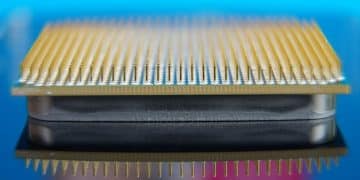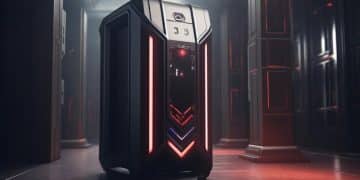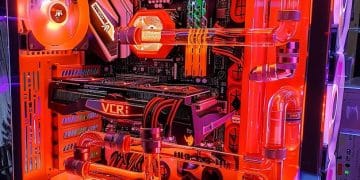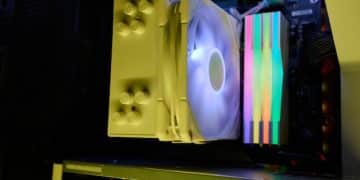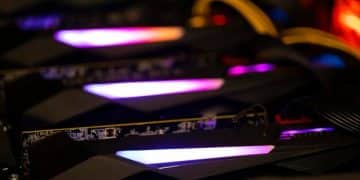Address CPU Bottleneck: Identify, Upgrade for 2025
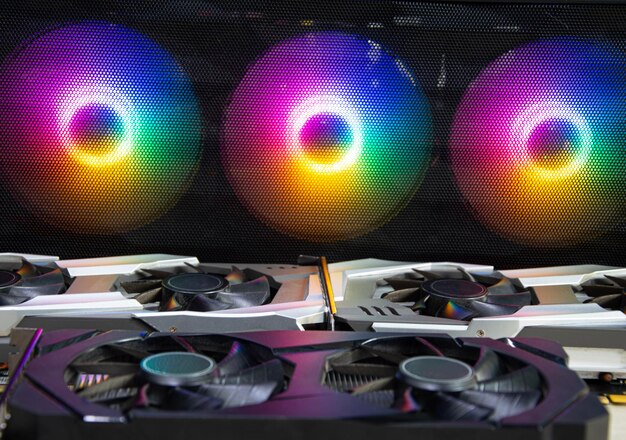
Diagnosing whether your CPU is bottlenecking your GPU is crucial for optimizing gaming performance, requiring a systematic approach of monitoring resource utilization, benchmarking, and identifying performance limitations to ensure a balanced system compatible with 2025 hardware advancements.
In the evolving landscape of PC gaming, a common frustration arises when a powerful graphics card doesn’t deliver the expected performance. Often, the culprit isn’t the GPU itself, but an underpowered central processing unit (CPU) creating a bottleneck. This guide explores the signs, methods to identify, and strategies to address the question: Is Your CPU Bottlenecking Your GPU? A Guide to Identifying and Upgrading Your Processor in 2025, ensuring your gaming rig is optimally balanced for the demands of tomorrow’s titles.
Understanding the CPU-GPU Dynamic in Gaming
The synergy between your CPU and GPU is fundamental to a smooth and immersive gaming experience. While the graphics card is responsible for rendering the detailed visuals you see on screen, the processor handles a multitude of background tasks that are just as vital, including game logic, artificial intelligence (AI), physics calculations, and the processing of input from your peripherals. A delicate balance is required for optimal performance; if one component cannot keep pace with the other, it creates a bottleneck, hindering the overall system capacity.
In simple terms, a CPU bottleneck occurs when your processor reaches its maximum utilization before your graphics card does. This means the CPU can’t feed data to the GPU fast enough, leaving the GPU underutilized and unable to render frames at its full potential. The result? Lower frame rates, inconsistent performance, and a gaming experience that falls short of what your expensive GPU is capable of delivering. Identifying this imbalance is the first step towards unlocking your system’s true power.
The Role of Each Component
Understanding the distinct roles of the CPU and GPU helps clarify their interaction. The GPU, or Graphics Processing Unit, is a specialized processor designed for parallel computation, making it exceptionally good at rendering millions of pixels simultaneously. It draws the game world, characters, effects, and textures. On the other hand, the CPU, or Central Processing Unit, is the general-purpose workhorse. It manages all the non-graphical aspects of a game, from managing game states and player inputs to simulating vast open worlds and complex character behaviors.
- CPU’s Core Functions:
- Game world simulation and physics.
- Artificial Intelligence (AI) for NPCs and enemies.
- Audio processing and network communication.
- Drawing calls and preparing data for the GPU.
- GPU’s Core Functions:
- Rendering textures, models, and visual effects.
- Shader computations for lighting and shadows.
- Outputting frames to your display.
When the CPU struggles to complete its tasks quickly enough, it delays the flow of information to the GPU. This can manifest as stuttering, lower average frame rates, and particularly noticeable frame rate drops in CPU-intensive scenarios like busy open-world environments or large-scale battles. The key is to have a processor that can efficiently keep up with the demands placed upon it by modern game engines and high-refresh-rate monitors.
As games become more complex and graphically demanding in 2025, the strain on both components increases. Newer titles push the boundaries of realism, often requiring more sophisticated AI, larger environments, and more detailed physics simulations, all of which fall squarely on the CPU’s shoulders. Simultaneously, higher resolutions and refresh rates demand even more from the GPU. Therefore, maintaining a balanced system, where neither component unduly limits the other, becomes a perpetual challenge for PC gamers and builders alike.
Key Indicators of a CPU Bottleneck
Identifying a CPU bottleneck isn’t always straightforward, but several common indicators can point to an imbalanced system. Paying attention to these signs can help you determine if your processor is holding back your graphics card, rather than investing in an unnecessary GPU upgrade. Understanding these symptoms is the critical first step towards optimizing your gaming rig for peak performance, especially with the increasingly complex game architectures expected by 2025.
One of the most obvious indicators is low GPU utilization while gaming. If you’re playing a graphically intensive game and notice your GPU usage hovering well below 90-100%, even when frame rates are lower than expected, your CPU might be the restricting factor. The GPU is essentially waiting for the CPU to send it tasks, leading to underperformance. Conversely, if your CPU utilization is consistently at or near 100% while your GPU usage is low, it’s a strong sign that your processor is indeed struggling to keep up with the demands of the game.
Performance Monitoring Through Software
The most effective way to detect a CPU bottleneck is through real-time performance monitoring. Several software tools allow you to overlay critical system statistics directly onto your screen while you play, giving you immediate insights into component utilization. This proactive approach helps diagnose issues as they occur, rather than guessing after the fact.
- MSI Afterburner: This popular tool allows comprehensive monitoring of both CPU and GPU statistics, including utilization, temperatures, clock speeds, and memory usage. It provides a customizable on-screen display (OSD) that brings these metrics directly into your game.
- HWMonitor/HWInfo64: While not providing an in-game overlay, these tools offer detailed readings of all hardware sensors, making them excellent for post-game analysis or for identifying peak loads on components.
- Windows Task Manager: A built-in solution, Task Manager can provide a quick overview of CPU and GPU utilization under the “Performance” tab, though it lacks the granular detail of dedicated monitoring software.
By using these tools, specifically MSI Afterburner, you can observe the percentage of resource utilization for both your CPU and GPU simultaneously. A common pattern indicating a CPU bottleneck would be high CPU usage (often 90-100%) paired with significantly lower GPU usage (e.g., 50-70%). This imbalance suggests your CPU is the limiting factor, unable to process game data fast enough to fully occupy your GPU.
Another common indicator is inconsistent frame rates, characterized by frequent and noticeable dips, especially in demanding scenarios. Even if your average frame rate seems acceptable, severe fluctuations can indicate a CPU struggling to maintain stable performance under load. This is particularly noticeable in open-world games, strategy titles with many units, or multiplayer games with numerous players and AI calculations ongoing simultaneously. These “stuttering” effects dramatically impact the smoothness of gameplay and are a hallmark of an overworked processor.

Benchmarking and Testing for Bottlenecks
Beyond anecdotal observations and real-time monitoring, systematic benchmarking provides concrete data to confirm or deny the presence of a CPU bottleneck. Benchmarking involves running standardized tests that push your system to its limits, providing measurable performance metrics that can be compared against expected results or other hardware configurations. This method is particularly valuable for identifying how your specific hardware combination performs under various loads and resolutions, offering clear insights into where limitations lie.
To effectively test for a CPU bottleneck, it’s crucial to examine performance across different resolutions and settings. High resolutions (e.g., 4K) and detailed graphical settings tend to be more GPU-bound, meaning the GPU is the primary limiting factor. Conversely, lower resolutions (e.g., 1080p) or scenarios with very high refresh rates can shift the burden more onto the CPU. If you experience a significant performance jump when lowering the resolution or certain CPU-intensive settings (like draw distance or AI density) without a corresponding increase in GPU utilization, it’s a strong indication that your CPU is the bottleneck.
Synthetic Benchmarks vs. Real-World Gaming
A comprehensive testing strategy typically involves both synthetic benchmarks and real-world gaming tests. Each type offers unique advantages for diagnosing system performance.
- Synthetic Benchmarks: These are dedicated applications designed to stress specific components of your system in a controlled environment.
- 3DMark (Time Spy / Fire Strike): Offers comprehensive tests that provide scores for both graphics and CPU performance, allowing for direct comparison and identification of imbalances.
- Cinebench: Focuses purely on CPU rendering performance, helping to gauge your processor’s raw multi-core and single-core power, which is crucial for modern games that increasingly leverage multiple threads.
- PCMark: Tests overall system performance across a range of common computing tasks, including light gaming, offering a broader system benchmark.
- Real-World Gaming Tests: Playing actual games with integrated benchmarks or using performance monitoring tools offers the most accurate representation of your gaming experience.
- Many modern games include built-in benchmarks (e.g., Cyberpunk 2077, Assassin’s Creed Valhalla). These are invaluable as they simulate actual gameplay scenarios.
- Play your most demanding games and closely monitor CPU/GPU utilization with tools like MSI Afterburner. Focus on areas where frame rates drop significantly or stuttering occurs.
When running these tests, systematically change settings to observe the impact. For example, run a game’s benchmark at 1080p, then at 1440p, and finally at 4K. If your GPU utilization is significantly lower at 1080p than at 4K, and your CPU is maxed out at 1080p, you’ve likely found your bottleneck. Similarly, toggling extreme settings like crowd density or advanced physics can reveal CPU limitations, as these place direct demands on the processor’s capabilities.
Documentation of your results is also key. Keep a spreadsheet of frame rates, average CPU/GPU utilization, and specific game settings for each test. This data allows for objective comparison and helps you draw informed conclusions about your system’s balance. Remember that a perfectly balanced system is rare; minor bottlenecks are common. The goal is to identify if the bottleneck is severe enough to significantly degrade your gaming experience or prevent your GPU from performing near its potential.
Strategies for Addressing a CPU Bottleneck
Once you’ve confidently identified a CPU bottleneck, the next step is to address it. Depending on your budget, technical comfort, and current hardware, several strategies can help alleviate the issue and improve your gaming performance. From optimizing software settings to a complete hardware overhaul, each approach offers a different level of impact and investment, crucial considerations for a setup aiming for 2025 readiness.
Before considering a hardware upgrade, it’s always wise to explore software-based solutions. Ensuring your system drivers are up to date, especially for your GPU and chipset, can often yield performance improvements. Outdated drivers can lead to inefficiencies, preventing your CPU and GPU from communicating effectively. Regularly checking for and installing the latest drivers from your component manufacturers’ websites is a simple yet crucial maintenance task that can often resolve minor performance hiccups or improve overall stability.
Software Optimizations and Settings Tweaks
Beyond driver updates, tweaking in-game settings and operating system configurations can sometimes mitigate a CPU bottleneck without needing new hardware. These adjustments tend to reduce the workload on your CPU, allowing it to keep pace with the GPU more effectively.
- In-Game Settings:
- Lowering CPU-Intensive Settings: Reduce settings like “Draw Distance,” “Crowd Density,” “Physics Quality,” and “AI Quality.” These settings directly impact the amount of processing the CPU needs to do.
- Resolution and Refresh Rate: While contradictory to a GPU bottleneck, sometimes increasing resolution can shift the bottleneck to the GPU, making the CPU less of a limiting factor. However, this may not be ideal for high refresh rate gaming at lower resolutions.
- Operating System Optimizations:
- Background Processes: Close unnecessary applications running in the background while gaming. These programs consume CPU cycles and RAM that could otherwise be dedicated to the game.
- Power Plan Settings: Ensure your Windows power plan is set to “High Performance” to prevent your CPU from throttling its speed, which could further exacerbate a bottleneck.
- Game Mode: Windows’ Game Mode feature can optimize system resources for gaming, prioritizing game processes over background tasks.
While software tweaks can offer some relief, they are often temporary measures for a more fundamental hardware imbalance. For a significant and lasting improvement, especially for games launching in 2025 and beyond, a hardware upgrade is frequently the most effective solution. This typically involves upgrading your CPU, and potentially your motherboard and RAM, to ensure compatibility and unlock full performance.
When considering a hardware upgrade, ensure the new CPU is compatible with your existing motherboard socket and chipset. If not, a motherboard upgrade will also be necessary. This also often means upgrading your RAM, as newer CPUs and motherboards typically support faster, more efficient RAM standards (e.g., DDR5 instead of DDR4). Planning these interconnected upgrades ensures a smooth transition and avoids new compatibility issues, providing a robust foundation for future gaming experiences.
Upgrading Your Processor in 2025
If software optimizations aren’t enough, upgrading your CPU is the most direct way to eliminate a bottleneck. However, the process isn’t as simple as swapping out one chip; it requires careful consideration of compatibility, performance per dollar, and future-proofing, especially as we look towards 2025. The processor landscape is constantly evolving, with new architectures and technologies emerging that offer significant performance gains over older generations.
Before purchasing a new CPU, determine your current motherboard’s socket type (e.g., LGA1700 for Intel, AM5 for AMD) and chipset. This dictates which processors are compatible. Often, upgrading to a higher-tier CPU within the same generation and socket is the easiest path. For example, if you have an older Intel i5 on an LGA1200 socket, upgrading to a newer i7 or i9 on the same socket might be a viable option if your motherboard supports it. However, if your motherboard’s socket is several generations old, a complete platform upgrade (CPU, motherboard, and often RAM) is likely unavoidable.
Key Considerations for a CPU Upgrade
When selecting a new processor, several factors play a crucial role in determining its suitability for your gaming setup and its ability to alleviate a CPU bottleneck. Balancing these aspects ensures you get the best value and performance for your investment.
- Cores and Threads: Modern games increasingly leverage multiple cores. A higher core/thread count provides better multitasking capabilities and improves performance in games optimized for multi-threading.
- Clock Speed: Higher clock speeds (GHz) generally mean faster processing within each core, translating to better performance in games that are still largely single-threaded dependent.
- Cache Size: A larger L3 cache can significantly improve gaming performance by reducing the time the CPU spends retrieving data from slower system RAM.
- Compatibility (Socket and Chipset): As mentioned, ensure the new CPU fits your motherboard’s socket and is supported by its chipset. Check the motherboard manufacturer’s website for a list of supported CPUs.
- Power Consumption and Cooling: More powerful CPUs consume more power and generate more heat. Ensure your power supply unit (PSU) can handle the increased wattage, and your CPU cooler (air or liquid) is sufficient to maintain optimal temperatures.
For 2025, mid-range to high-end CPUs from both Intel (e.g., Core i5/i7/i9 series) and AMD (e.g., Ryzen 5/7/9 series) are generally excellent choices for gaming. Look for processors that offer a good balance of high single-core performance (still crucial for many games) and a decent number of cores and threads for future multi-threaded game optimization. Research specific benchmarks for your target games with your desired CPU/GPU combination to make an informed decision.
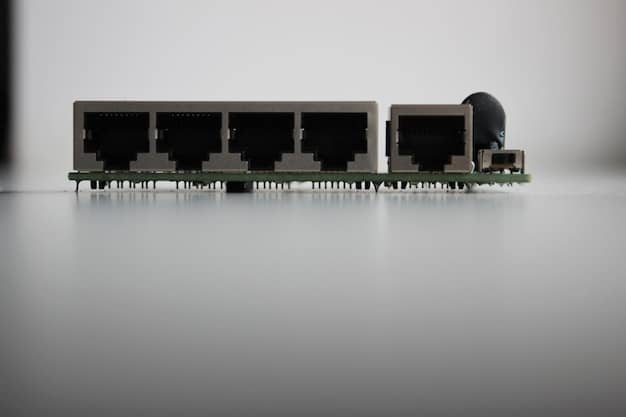
The cost of a CPU upgrade can range from a few hundred dollars for a drop-in replacement on an existing platform to over a thousand for a complete platform overhaul. Factor in the cost of a new motherboard and potentially new RAM, as these are often necessary for significant generational leaps. While it’s a considerable investment, addressing a severe CPU bottleneck is often the most impactful upgrade for overall system responsiveness and gaming performance, allowing your high-end GPU to finally stretch its legs and deliver the frame rates it was designed for.
Future-Proofing Your Gaming Rig for 2025 and Beyond
As we navigate the rapidly advancing world of gaming hardware, the concept of “future-proofing” becomes increasingly pertinent. While no system can truly withstand the test of time indefinitely, making informed decisions during upgrades can significantly extend the lifespan of your gaming rig and ensure it remains capable of handling future titles. Achieving this requires looking beyond immediate performance gains and considering upcoming technological shifts and the evolving demands of game development.
One primary aspect of future-proofing involves understanding the trajectory of gaming technology. Games in 2025 are expected to push boundaries in terms of graphical fidelity, AI complexity, and environmental interactivity. This trend suggests that both GPUs and CPUs will face increasing workloads. Opting for a CPU with a higher core count and robust multi-threading capabilities, even if not fully utilized by all current games, is a wise investment. This foresight prepares your system for titles that will undoubtedly leverage more CPU threads for richer, more dynamic game worlds.
Adapting to Technological Advancements
The PC hardware landscape is never stagnant. New CPU architectures, memory standards, and interface technologies are constantly emerging, each offering potential performance benefits. Being aware of these advancements can guide your upgrade decisions.
- PCIe 5.0 and Beyond: Newer motherboards and CPUs often support PCIe 5.0, offering increased bandwidth for GPUs and NVMe SSDs. While currently, PCIe 4.0 is sufficient for most GPUs, investing in PCIe 5.0 readiness can be beneficial for future ultra-high-end graphics cards.
- DDR5 RAM: DDR5 memory, with its higher frequencies and improved efficiency, is becoming the standard for new high-performance platforms. While DDR4 can still be adequate, upgrading to DDR5 alongside a new CPU/motherboard ensures your memory subsystem won’t be a future bottleneck.
- CPU Architectures: Both Intel and AMD are continuously refining their CPU architectures, delivering more instructions per cycle (IPC) and better power efficiency. Researching the latest generations and their iterative improvements can help identify CPUs with strong long-term performance potential.
- Platform Longevity: Consider the expected longevity of CPU sockets. AMD’s AM5 socket, for example, is planned for multiple generations, potentially allowing for easier future CPU upgrades within the same motherboard. Intel’s sockets tend to have shorter lifespans, often requiring a new motherboard for major CPU upgrades.
Building a future-proofed PC isn’t about buying the absolute top-tier components at all times, which is often uneconomical. Instead, it’s about making strategic choices that offer a strong performance foundation without overspending on features unlikely to yield significant returns for your specific use case. For example, a high-end CPU paired with a powerful GPU provides a balanced system that can remain competitive for several years, even as new games and technologies emerge.
Finally, consider the power supply and cooling solutions. A robust power supply with sufficient wattage provides headroom for future component upgrades, ensuring you don’t need to replace it every time you upgrade a major component. Similarly, investing in an effective CPU cooler will allow your processor to run at optimal temperatures, preventing thermal throttling and extending its lifespan. A little foresight in these areas can save significant time and money down the line, ensuring your gaming PC remains a formidable machine for years to come.
Common Pitfalls and Misconceptions About Bottlenecks
While understanding and addressing CPU bottlenecks is crucial for optimal gaming performance, the topic is often surrounded by misconceptions and common pitfalls. These can lead to unnecessary upgrades, misdiagnoses, or frustration when expected performance gains don’t materialize. As a journalist specializing in technology, it’s important to clarify these points to ensure readers make informed decisions about their gaming hardware.
One of the most persistent misconceptions is the idea that any bottleneck is inherently “bad” and must be eliminated. In reality, a truly “balanced” system where both the CPU and GPU are utilized at exactly 100% simultaneously is exceptionally rare and often impractical. In almost every system, under every gaming scenario, one component will almost always be working harder or waiting for the other. The goal isn’t to eliminate all bottlenecks, but to ensure that the bottleneck isn’t severe enough to noticeably degrade your gaming experience or prevent your primary components (like an expensive GPU) from performing near their full potential.
Myths and Realities
Let’s debunk some common myths surrounding CPU and GPU bottlenecks:
- Myth: “My powerful GPU is always bottlenecked by my CPU.”
- Reality: Bottlenecks are highly dependent on the game, resolution, and in-game settings. A game that is CPU-intensive (e.g., simulation, strategy) might bottleneck your CPU at 1080p, but at 4K, the same game will almost certainly become GPU-bound.
- Myth: “100% CPU usage means a bottleneck.”
- Reality: While high CPU usage can indicate a bottleneck, it’s not always a problem if performance is good. Some games are designed to highly utilize the CPU. The key is to see if your GPU usage is consistently low while your CPU is maxed, indicating the GPU is waiting.
- Myth: “Upgrading my CPU will fix all my performance issues.”
- Reality: If your GPU is already the bottleneck at your desired resolution/settings, a CPU upgrade will yield little to no performance improvement. Always identify the true bottleneck before upgrading.
- Myth: “Only high-end CPUs are good for gaming.”
- Reality: Mid-range CPUs (e.g., Intel i5, AMD Ryzen 5) often provide excellent gaming performance, especially when paired with appropriate GPUs. The sweet spot for performance per dollar is often in this range rather than the absolute top-tier.
Another common pitfall is upgrading components without considering the power supply unit (PSU) or cooling solutions. A new, more powerful CPU or GPU will demand more power and produce more heat. An undersized PSU can lead to system instability, crashes, or even component damage. Similarly, inadequate cooling will cause components to thermal throttle, reducing their performance and negating the benefits of your upgrade. Always ensure your PSU has enough wattage and your CPU cooler can handle the thermal design power (TDP) of your new processor.
Lastly, avoid relying solely on online “bottleneck calculators.” While these tools can offer a rough estimate, they rarely account for the nuances of specific game engines, individual system configurations, or user-specific settings. Real-world testing with performance monitoring software in your actual gaming scenarios is always the most accurate method for identifying bottlenecks. Trust your own data and observations over generalized online calculators, ensuring your upgrade path is based on verifiable information rather than abstract predictions.
| Key Aspect | Brief Description |
|---|---|
| 📊 Diagnose & Monitor | Use tools like MSI Afterburner to check CPU/GPU utilization for imbalance. |
| 🛠️ Optimize Software | Update drivers, tweak in-game settings (e.g., draw distance) to reduce CPU load. |
| 🚀 Consider CPU Upgrade | If severe, research compatible CPUs, considering core count, clock speed, and cache. |
| 💡 Future-Proofing | Invest in modern platforms (PCIe 5.0, DDR5) and robust cooling for longevity. |
Frequently Asked Questions
▼
A CPU bottleneck typically manifests as lower-than-expected frame rates, inconsistent performance, or stuttering, especially in CPU-intensive game areas. You’ll often see high CPU utilization (near 100%) combined with lower GPU utilization (<90%), indicating your GPU is waiting for the CPU.
▼
MSI Afterburner with Rivatuner Statistics Server is the most recommended tool. It provides an in-game overlay displaying real-time CPU and GPU utilization, temperatures, and frame rates. Other tools like HWMonitor or Windows Task Manager can also offer valuable insights.
▼
Sometimes. You can try updating drivers, closing background applications, using Windows Game Mode, and lowering CPU-intensive in-game settings like draw distance or crowd density. These optimizations can reduce the CPU’s workload, but severe bottlenecks often require a hardware upgrade.
▼
Consider upgrading when performance monitoring consistently shows high CPU usage and low GPU usage in your preferred games, leading to unsatisfactory frame rates. This is especially true if you have a powerful GPU that isn’t being fully utilized by your current processor.
▼
For 2025, prioritize a CPU with strong single-core performance, a good number of cores/threads (e.g., 6-8 cores minimum for mid-range), a large L3 cache, and compatibility with a modern motherboard socket that offers upgrade paths (like AM5). Also, ensure your PSU and cooling are sufficient.
Conclusion
Navigating the complexities of PC hardware, especially when it comes to identifying and resolving performance bottlenecks, requires a blend of keen observation, systematic testing, and informed decision-making. The question of “Is Your CPU Bottlenecking Your GPU?” is not merely a technical query but a gateway to unlocking your gaming rig’s full potential. By understanding the dynamic interplay between your processor and graphics card, utilizing effective monitoring tools, and applying a strategic approach to upgrades, gamers can ensure their systems are not only delivering optimal performance today but are also well-prepared for the evolving demands of titles in 2025 and beyond.
